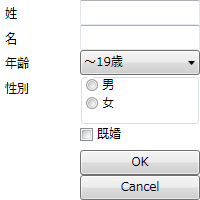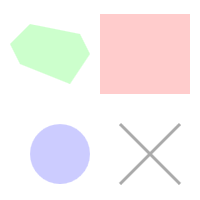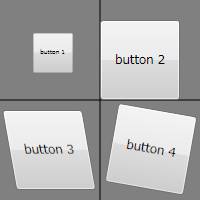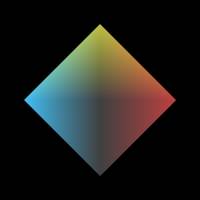概要
WPF で最初から用意されている GUI 要素や機能は膨大で、とても全部を紹介することはできませんが、 代表的なものをいくつか紹介します。
コントロール
System.Windows.Controls 名前空間内に、 ボタン、テキストボックス、チェックボックス、ラジオボタンなど、 ユーザからの入力操作を受け付けるためのコントロール類が定義されています。
<Grid
xmlns="http://schemas.microsoft.com/winfx/2006/xaml/presentation"
xmlns:x="http://schemas.microsoft.com/winfx/2006/xaml"
Width="200" Height="200">
<Grid.RowDefinitions>
<RowDefinition Height="25" />
<RowDefinition Height="25" />
<RowDefinition Height="25" />
<RowDefinition Height="50" />
<RowDefinition Height="25" />
<RowDefinition Height="25" />
<RowDefinition Height="25" />
</Grid.RowDefinitions>
<Grid.ColumnDefinitions>
<ColumnDefinition Width="80" />
<ColumnDefinition Width="120" />
</Grid.ColumnDefinitions>
<Label Grid.Row="0" Grid.Column="0">姓</Label>
<TextBox Grid.Row="0" Grid.Column="1"></TextBox>
<Label Grid.Row="1" Grid.Column="0">名</Label>
<TextBox Grid.Row="1" Grid.Column="1"></TextBox>
<Label Grid.Row="2" Grid.Column="0">年齢</Label>
<ComboBox Grid.Row="2" Grid.Column="1" SelectedIndex="0">
<ComboBoxItem >~19歳</ComboBoxItem>
<ComboBoxItem>20代</ComboBoxItem>
<ComboBoxItem>30代</ComboBoxItem>
<ComboBoxItem>40代</ComboBoxItem>
<ComboBoxItem>それ以上</ComboBoxItem>
</ComboBox>
<Label Grid.Row="3" Grid.Column="0">性別</Label>
<GroupBox Grid.Row="3" Grid.Column="1">
<StackPanel>
<RadioButton Height="18">男</RadioButton>
<RadioButton Height="18">女</RadioButton>
</StackPanel>
</GroupBox>
<CheckBox Grid.Row="4" Grid.Column="1">既婚</CheckBox>
<Button Grid.Row="5" Grid.Column="1">OK</Button>
<Button Grid.Row="6" Grid.Column="1">Cancel</Button>
</Grid>
図形
System.Windows.Shapes 名前空間内に、 直線、円、多角形などの図形が定義されています。 これらの図形はベクタグラフィックになっていて、 拡大・縮小してもふちがギザギザになったりしません。
<Canvas
xmlns="http://schemas.microsoft.com/winfx/2006/xaml/presentation"
xmlns:x="http://schemas.microsoft.com/winfx/2006/xaml"
Width="200" Height="200">
<Rectangle Canvas.Left="100" Canvas.Top="10"
Width="90" Height="80" Fill="#ffcccc"/>
<Ellipse Canvas.Left="30" Canvas.Top="120"
Width="60" Height="60" Fill="#ccccff"/>
<Polygon Canvas.Left="10" Canvas.Top="10"
Points="20 10 70 20 80 40 60 70 10 50 0 30"
Fill="#ccffcc"
/>
<Line Stroke="#aaaaaa" StrokeThickness="3"
X1="120" Y1="120" X2="180" Y2="180"/>
<Line Stroke="#aaaaaa" StrokeThickness="3"
X1="180" Y1="120" X2="120" Y2="180"/>
</Canvas>
メディア
System.Windows.Media 名前空間内には多彩な機能が用意されています。
まず、 コントロールや図形の背景にグラデーションをかけたり画像を表示したり、 回転・拡大・平行移動などの変形を施す機能があります。
また、System.Windows.Shapes で定義されている基本的な図形に加えて、 ベジエ曲線等を用いた複雑な図形の描写機能があります。
さらに、静止画、音声、動画などを再生・表示する機能があります。
<Canvas
xmlns="http://schemas.microsoft.com/winfx/2006/xaml/presentation"
xmlns:x="http://schemas.microsoft.com/winfx/2006/xaml"
Width="200" Height="200" Background="#808080">
<Rectangle Canvas.Left="5" Canvas.Top="5" Width="90" Height="90">
<Rectangle.Fill>
<LinearGradientBrush>
<GradientStop Color="#aaaaff" Offset="0" />
<GradientStop Color="#aaffff" Offset="1" />
</LinearGradientBrush>
</Rectangle.Fill>
</Rectangle>
<Rectangle Canvas.Left="105" Canvas.Top="5" Width="90" Height="90">
<Rectangle.Fill>
<RadialGradientBrush>
<GradientStop Color="#ffaaaa" Offset="0" />
<GradientStop Color="#ffffaa" Offset="1" />
</RadialGradientBrush>
</Rectangle.Fill>
</Rectangle>
<Rectangle Canvas.Left="5" Canvas.Top="105" Width="90" Height="90">
<Rectangle.Fill>
<RadialGradientBrush>
<GradientStop Color="#ffffff" Offset="0" />
<GradientStop Color="#ffaaff" Offset="1" />
</RadialGradientBrush>
</Rectangle.Fill>
</Rectangle>
<Rectangle Canvas.Left="105" Canvas.Top="105" Width="90" Height="90">
<Rectangle.Fill>
<LinearGradientBrush>
<GradientStop Color="#aaffaa" Offset="0" />
<GradientStop Color="#aaaaaa" Offset="1" />
</LinearGradientBrush>
</Rectangle.Fill>
</Rectangle>
</Canvas>
<Canvas
xmlns="http://schemas.microsoft.com/winfx/2006/xaml/presentation"
xmlns:x="http://schemas.microsoft.com/winfx/2006/xaml"
Width="200" Height="200" Background="#808080">
<Line X1="100" Y1="0" X2="100" Y2="200" Stroke="Black"/>
<Line X1="0" Y1="100" X2="200" Y2="100" Stroke="Black"/>
<Button Canvas.Left="10" Canvas.Top="10" Width="80" Height="80">
<Button.RenderTransform>
<ScaleTransform CenterX="45" CenterY="45" ScaleX="0.5" ScaleY="0.5"/>
</Button.RenderTransform>
button 1
</Button>
<Button Canvas.Left="110" Canvas.Top="10" Width="80" Height="80">
<Button.RenderTransform>
<TranslateTransform X="-10" Y="10"/>
</Button.RenderTransform>
button 2
</Button>
<Button Canvas.Left="10" Canvas.Top="110" Width="80" Height="80">
<Button.RenderTransform>
<SkewTransform CenterX="45" CenterY="45" AngleX="10"/>
</Button.RenderTransform>
button 3
</Button>
<Button Canvas.Left="110" Canvas.Top="110" Width="80" Height="80">
<Button.RenderTransform>
<RotateTransform CenterX="45" CenterY="45" Angle="10"/>
</Button.RenderTransform>
button 4
</Button>
</Canvas>
3次元モデル
特に、 System.Windows.Media.Media3D 名前空間内には、 3次元モデルの表示機能があります。
カメラの向きを設定して、 光源を置いて、 3次元モデルを置く感じで、割と簡単に作れます。
3次元モデルの作り方は、 いわゆるメッシュ(多面体の頂点と、頂点のつなぎ方を指定して物体を作る)構造がメインのようです。 (以下の例では、頂点の座標を全部 XAML 中に打っていますが、 3次元モデル生成アプリで作ったデータを読んだりもできるようです。)
以下の例では、 正8面体を作って、3方向から指向性の光を当てています。 (本当は手抜きしてて、8面体の表から見える側だけ作ってる。)
<Canvas
xmlns="http://schemas.microsoft.com/winfx/2006/xaml/presentation"
xmlns:x="http://schemas.microsoft.com/winfx/2006/xaml"
Width="200" Height="200" Background="Black">
<Viewport3D Width="200" Height="200">
<!-- カメラ -->
<Viewport3D.Camera>
<PerspectiveCamera Position="0,0,15" FieldOfView="10"
LookDirection="0,0,-1" UpDirection="0, 1, 0"/>
</Viewport3D.Camera>
<!-- 物体 -->
<ModelVisual3D>
<ModelVisual3D.Content>
<GeometryModel3D>
<GeometryModel3D.Geometry>
<MeshGeometry3D
Positions="1 0 0, 0 1 0, -1 0 0, 0 -1 0, 0 0 1"
TriangleIndices="0 1 4, 1 2 4, 2 3 4, 3 0 4"
/>
</GeometryModel3D.Geometry>
<GeometryModel3D.Material>
<DiffuseMaterial>
<DiffuseMaterial.Brush>
<SolidColorBrush Color="White"/>
</DiffuseMaterial.Brush>
</DiffuseMaterial>
</GeometryModel3D.Material>
</GeometryModel3D>
</ModelVisual3D.Content>
</ModelVisual3D>
<!-- 光源 -->
<ModelVisual3D>
<ModelVisual3D.Content>
<Model3DGroup>
<AmbientLight Color="#404040" />
<DirectionalLight Color="#ff0000" Direction="-1,-1,0" />
<DirectionalLight Color="#0000ff" Direction="1,0,0" />
<DirectionalLight Color="#00ff00" Direction="1,-1,0" />
</Model3DGroup>
</ModelVisual3D.Content>
</ModelVisual3D>
</Viewport3D>
</Canvas>
その他のサンプル →
viewport3d.xaml 。 正8面体を6個置いて、カメラを回して写しています。





